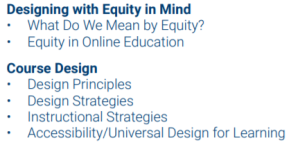Lesson 3 The Learner and Instructional Design
3-4 Equity and Inclusion in eLearning
Addressing Equity and Inclusion
You will have learners who have poor vision, noisy rooms, slow internet, limited resources, aging technology, busy lives, and the list goes on and on. But you can anticipate some of these needs and build eLearning that works using inclusive strategies for learners with physical, sensory, learning, socioeconomic, and time deficits.
- In case you are designing academic eLearning, the Intercultural Development Research Association has timely advice on Ensuring Equity in Online Learning in response to the pandemic of 2020. (Mar 2020)
- Georgetown University provides a brief overview with evidence on Inclusive Pedagogy.
- And there are several scholarly articles on equity in eLearning ranging as far back as 2000.
Learner Accessibility
The most important thing you can do with your eLearning project is to think about accessibility for all types of learners, not just those with physical disabilities. We’ll look at accessibility later (in Week 8) in terms of navigating your eLearning, but it needs to be understood now at the learner level that you will have to build for it.
- Sheryl Burgstahler from UW DO-IT provides an accessible checklist in Equal Access: Universal Design of Distance Learning Programs. (2017)
- Martin LaGrow explains the legal basis for accessibility and how to be proactive in From Accommodation to Accessibility: Creating a Culture of Inclusivity. (Mar 2017)
- Learn about Universal Design for Learning from CAST; this is the definitive source for UDL.
⭐Shar’s Note: My final recommendation is a resource some of you may think you don’t need, but I guarantee you everyone can find something here to use from designers to instructors to administrators: Delivering High-Quality Instruction Online in Response to COVID–19 Faculty Playbook.
This playbook uses a design – enhance – optimize approach to the tips they offer on a variety of topics. Here’s a small sample of some of the topics.

